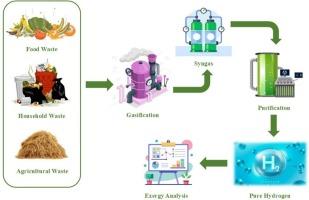Hydrogen production from organic waste in Bangladesh: Impacts of temperature and steam flow on syngas composition
IF 7.6
Q1 ENERGY & FUELS
引用次数: 0
Abstract
More than 0.13 million tons of waste are generated annually, making conventional methods of treatment including anaerobic digestion, incineration, and landfilling insufficient.Thus, a long-term solution is required.Therefore, this study used a process modeling through Aspen Plus V11 to investigate how variations in waste types and gasification temperatures affect the ability to producing hydrogen. Additionally, the use of a Steam Rankin Cycle has been used to optimize the economy through generation. To explore the potential of various type of waste, proximate and Ultimate analysis have been done experimentally in lab and some of them (Rice Husk, Rice Straw, Sugar-cane Baggage, Cow-dung etc.) have been taken from references. This study presents validation against experimental data using dolomite and olivine as bed materials. The model showed strong agreement with experimental results, accurately predicting hydrogen concentration, CO, and CO2. A detailed thermodynamic analysis revealed an increase in hydrogen purity from 50.9 % in raw syngas to 100 % after pressure swing adsorption (PSA), accompanied by an exergy reduction from 48.99 MW to 34.68 MW due to separation and thermal losses. Parametric studies demonstrated that gasification temperatures between 750 °C and 800 °C and steam-to-biomass ratios of 0.4–0.5 optimize hydrogen production. Feedstock type significantly influenced performance; rice straw, rice husk, jute stick, and cow dung exhibited higher hydrogen yields compared to food waste. The model predicted a hydrogen production rate of approximately 1020 kg/h per ton of dry feedstock, with an overall system efficiency of 48.5 % based on exergy analysis.

孟加拉国有机废物制氢:温度和蒸汽流量对合成气成分的影响
每年产生的垃圾超过13万吨,传统的处理方法,包括厌氧消化、焚烧和填埋,都是不够的。因此,需要一个长期的解决方案。因此,本研究使用Aspen Plus V11的过程建模来研究废物类型和气化温度的变化如何影响产生氢气的能力。此外,蒸汽兰金循环的使用已被用于通过发电优化经济。为了探索各种废弃物的潜力,在实验室进行了近似和极限分析实验,其中一些(稻壳、稻草、甘蔗袋、牛粪等)已从参考文献中获得。本研究以白云石和橄榄石为基材,对实验数据进行了验证。该模型与实验结果吻合较好,能较准确地预测氢浓度、CO和CO2。详细的热力学分析表明,变压吸附(PSA)后,原料合成气中的氢纯度从50.9%提高到100%,同时由于分离和热损失,火用从48.99 MW降低到34.68 MW。参数研究表明,气化温度在750°C至800°C之间,蒸汽与生物质的比例为0.4-0.5,可优化制氢。原料类型对性能影响显著;与食物垃圾相比,稻草、稻壳、黄麻和牛粪的产氢量更高。该模型预测,每吨干原料的产氢率约为1020kg /h,根据火用分析,整个系统效率为48.5%。
本文章由计算机程序翻译,如有差异,请以英文原文为准。
求助全文
约1分钟内获得全文
求助全文
来源期刊

Energy Conversion and Management-X
Multiple-
CiteScore
8.80
自引率
3.20%
发文量
180
审稿时长
58 days
期刊介绍:
Energy Conversion and Management: X is the open access extension of the reputable journal Energy Conversion and Management, serving as a platform for interdisciplinary research on a wide array of critical energy subjects. The journal is dedicated to publishing original contributions and in-depth technical review articles that present groundbreaking research on topics spanning energy generation, utilization, conversion, storage, transmission, conservation, management, and sustainability.
The scope of Energy Conversion and Management: X encompasses various forms of energy, including mechanical, thermal, nuclear, chemical, electromagnetic, magnetic, and electric energy. It addresses all known energy resources, highlighting both conventional sources like fossil fuels and nuclear power, as well as renewable resources such as solar, biomass, hydro, wind, geothermal, and ocean energy.
 求助内容:
求助内容: 应助结果提醒方式:
应助结果提醒方式:


